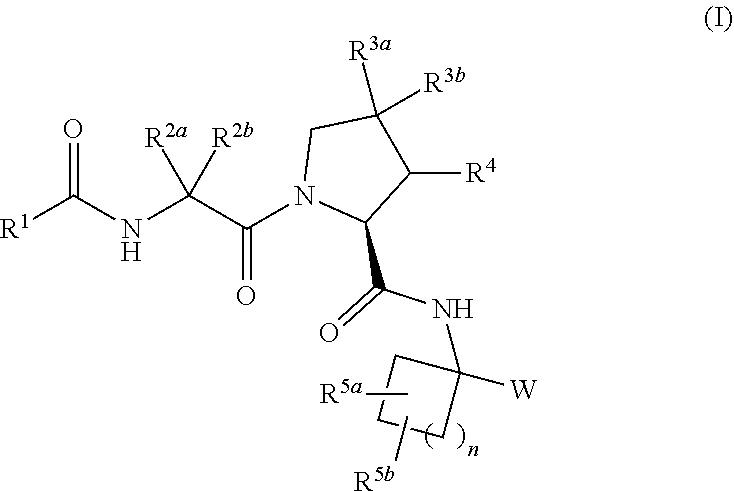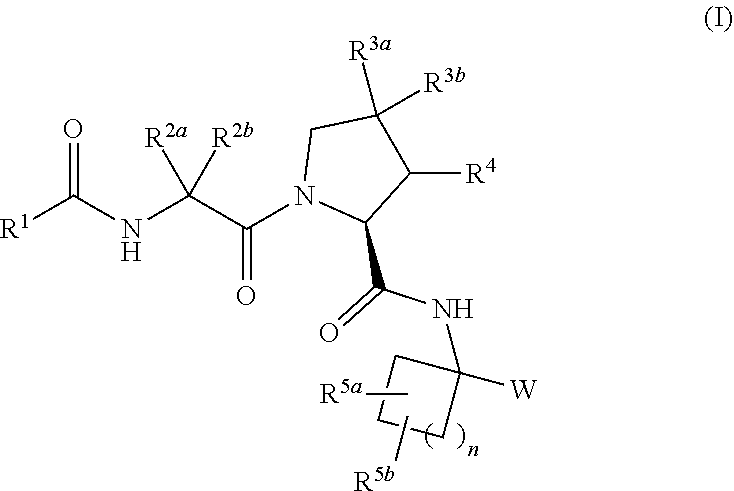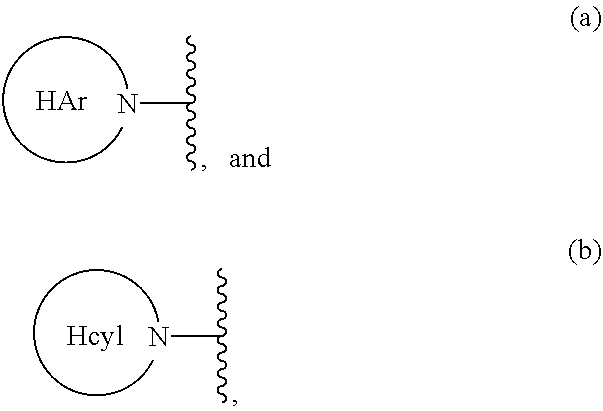Carbocyclic prolinamide derivatives
a technology of carbocyclic prolinamide and derivatives, applied in the field of carbocyclic prolinamide derivatives, can solve the problems of difficulty in distinguishing between iris pigmentation alone and other, increase the risk of amd, and impair vision, and achieve the effect of inhibiting the activity of htra1 protease and preventing and treating diseases
- Summary
- Abstract
- Description
- Claims
- Application Information
AI Technical Summary
Benefits of technology
Problems solved by technology
Method used
Image
Examples
example 1
-((R)-2-(2-naphthamido)-3-cyclohexylpropanoyl)-N-(1-(2-amino-2-oxoacetyl)cyclobutyl)-4-(5-(2-hydroxypropan-2-yl)-1H-1,2,3-triazol-1-yl)pyrrolidine-2-carboxamide
[0526]
Step 1: Preparation of (2S,4S)-1-((R)-2-(2-naphthamido)-3-cyclohexylpropanoyl)-N-(1-(2-amino-1-hydroxy-2-oxoethyl)cyclobutyl)-4-azidopyrrolidine-2-carboxamide
[0527]Into a 100 mL round-bottom flask, equipped with a magnetic stir bar and under nitrogen was added intermediate L (816 mg, 1.8 mmol, 1.0 equiv), intermediate A (350 mg, 1.9 mmol, 1.1 equiv) and HATU (737 mg, 1.9 mmol, 1.1 equiv). The solids were suspended in CH2Cl2 (anhydrous, 5 mL), treated with EtN(iPr)2 (615 μL, 3.5 mmol, 2.0 equiv) and the reaction mixture was stirred at room temperature for 1 hour. LCMS analysis revealed conversion to product. The reaction mixture was quenched with 1 M HCl (30 mL) and extracted with CH2Cl2 (3×30 mL) using a Cl-phase separator cartridge. The combined organic extracts were concentrated under reduced pressure. The residue was...
example 4
-((R)-2-(2-naphthamido)-3-cyclohexyipropanoyl)-N-(1-(2-amino-2-oxoacetyl)cyclohexyl)-4-(5-(2-hydroxypropan-2-yl)-1H-1,2,3-triazol-1-yl)pyrrolidine-2-carboxamide
[0532]
Step 1: Preparation of (2S,4S)-1-((R)-2-(2-naphthamido)-3-cyclohexylpropanoyl)-N-(1-(2-amino-1-hydroxy-2-oxoethyl)cyclohexyl)-4-azidopyrrolidine-2-carboxamide
[0533]Into a 50 mL round-bottom flask, equipped with a magnetic stir bar and under nitrogen was added intermediate L (326 mg, 0.70 mmol, 1.0 equiv), intermediate F (0.85 mmol, 1.2 equiv) and HATU (294 mg, 0.77 mmol, 1.1 equiv). The solids were suspended in CH2Cl2 (anhydrous, 2 mL), treated with EtN(iPr)2 (367 μL, 2.1 mmol, 3.0 equiv) and the reaction mixture was stirred at room temperature for 2 h. LCMS analysis revealed conversion to product. The reaction mixture was quenched with 1 M HCl (15 mL) and extracted with CH2Cl2 (3×10 mL) using a Cl-phase separator cartridge. The combined organic extracts were concentrated under reduced pressure. The residue was purified...
example 7
S)-1-((R)-2-(2-naphthamido)-3-cyclohexylpropanoyl)-4-(5-(2-hydroxypropan-2-yl)-1H-1,2,3-triazol-1-yl)pyrrolidine-2-carboxamido)cyclohexyl)boronic acid
[0538]
Step 1: Preparation of (2S,4S)-1-((R)-2-(2-naphthamido)-3-cyclohexylpropanoyl)-4-(5-(2-hydroxypropan-2-yl)-1H-1,2,3-triazol-1-yl)-N-(1-(4,4,5,5-tetramethyl-1,3,2-dioxaborolan-2-yl)cyclohexyl)pyrrolidine-2-carboxamide
[0539]Into a 4 mL sample vial equipped with a magnetic stir bar and under nitrogen was added intermediate M (103 mg, 0.19 mmol, 1.0 equiv), intermediate K (60 mg, 0.23 mmol, 1.2 equiv), PyAOP (120 mg, 0.23 mmol, 1.2 equiv), DMF (1 mL) and EtN(iPr)2 (66 μL, 0.38 mmol, 2.0 equiv). The yellow solution was stirred at room temperature for 18 hours. LCMS revealed approximately 40% product formation. The reaction mixture was quenched with water (5 mL) and extracted with DCM (3×5 mL) using a Cl-phase separatory cartridge. The combined organic extracts were concentrated under reduced pressure. The residue was purified by colum...
PUM
 Login to View More
Login to View More Abstract
Description
Claims
Application Information
 Login to View More
Login to View More - R&D
- Intellectual Property
- Life Sciences
- Materials
- Tech Scout
- Unparalleled Data Quality
- Higher Quality Content
- 60% Fewer Hallucinations
Browse by: Latest US Patents, China's latest patents, Technical Efficacy Thesaurus, Application Domain, Technology Topic, Popular Technical Reports.
© 2025 PatSnap. All rights reserved.Legal|Privacy policy|Modern Slavery Act Transparency Statement|Sitemap|About US| Contact US: help@patsnap.com



